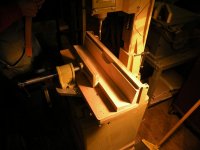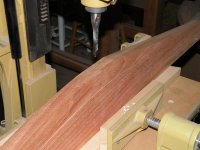Jeff,
Thanks for posting pictures of the cradle set up for the mortiser. I assume it is set up for a compound angle, as the rails are perpendicular to the ground, and the back legs cant outward at an angle. Also, do you make two sets for each chair, as the bottom rails are a slightly different angle than the seat rails? Do you flip the cradle when mortising the opposite leg, or just reset the mortiser? I made three chippendale side chairs recently and decided it would be easier to cut angled tenons v. angled mortises, though the compund angle on the tenons were sort of a pain. I like the idea of the mortiser jig, and am interested to hear more about your procedure.
Thanks,
Rob


